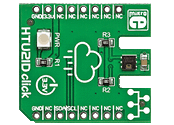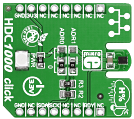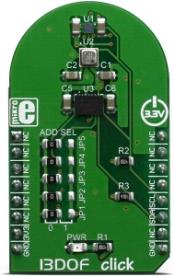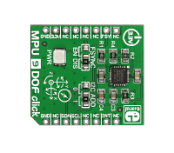Search
Search for "click":
(Click here to search this entire website for "click" with Google.)
 |

|
|
DHT22 click is a temperature and humidity measurement board carrying the sensor of the same name. It's a low cost reliable solution that communicates with the target board microcontroller through a single Serial Data Line. The sensor can detect temperatures between - 40 and 80 degrees centigrade with a half a degree precision. The relative humidity measurement from 0 - 100% is accurate within 2%. DHT22 has two jumpers. One for choosing between two mikroBUS pins (CS or INT) for communicating with the target board microcontroller. Another for setting up the power supply voltage either at 3.3V or 5V. |
|
|
|
 |

|
|
HTU21D click carries a high-precision, easy-to-use relative humidity sensor with temperature output. It's a great solution for quickly developing reliable environmental sensing nodes. The sensor is plug and play, requiring no calibration to use. The measurement range of HTU21D click is from 0 to 100 percents of relative humidity, and -40 to +125 degrees of Celsius. The board communicates with the target microcontroller through mikroBUS I2C lines: SCL (clock) and SDA (data). The default resolution of the signal is set to 12-bit for relative humidity and 14-bit for temperature readings. HTU21D click uses a 3.3V power supply. |
|
|
|
 |

|
|
DHT22 2 click is used for measuring the environmental temperature and relative humidity. It uses the CM2322 sensor, with very accurate thermal and humidity measuring capabilities. It can use either 1-Wire or I2C protocol to communicate with the integrated circuit.
Attributes like the ultra-small size, low power consumption,data signal transmission distance up to 20 meters, make this sensor the perfect choice for all kinds of applications that require measurement of the temperature and humidity. |
|
|
|
 |

|
|
HDC1000 click is a humidity (and temperature) measurement click board carrying the HDC1000 sensor from TI. Its chief features are low power consumption, precision, and resistance to dust, dirt, and similar environmental contaminants. The relative humidity (0-100%RH) is measured with an accuracy of ±3%; the temperature is measured within a range from -20°C to 85°C with ±0.2°C accuracy. HDC1000 click communicates with the target board MCU through mikroBUS I2C and INT lines. It operates as a slave device on the I2C interface. A pair of onboard jumpers allow you to specify the slave byte address, with four to choose from. The board is designed to use a 3.3V power supply only. |
|
|
|
 |

|
|
13DOF Click is an advanced 13-axis motion tracking Click board™, which utilizes three different sensor ICs onboard: BME680, a digital gas, humidity, pressure and temperature sensor and BMM150, a geomagnetic sensor and a BMI088, small, versatile 6DoF sensor module. All integrated sensors ICs are made by Bosch Sensortec, featuring the state-of-the-art sensor technology processes, in order to fulfill the requirements for immersive gaming and navigation applications, which require highly accurate sensor data fusion. Besides that, 13DOF click is also perfectly suited for use in many other applications such as mobile phones, tablet PCs, GPS systems, Smart watches, Sport and fitness devices, and many more.
13DOF click is supported by a mikroSDK compliant library, which includes functions that simplify software development. This Click board™ comes as a fully tested product, ready to be used on a system equipped with the mikroBUS™ socket.
|
|
|
|
 |

|
|
MPU 9DOF click carries the MPU-9150 System in Package, which is the world's first 9-axis Motion Tracking device. MPU-9150 comprises two chips. One is the MPU-6050 that contains a 3-axis accelerometer, a 3-axis gyroscope, and a DMP (digital motion processor); the other is AK8975, a 3-axis digital compass. The MPU-9150 is designed for the low power, low cost, and high performance requirements of consumer electronics equipment and wearable sensors. The ability to track motion in free space also makes MPU 9DOF click a suitable sensor for RC vehicle (e.g. quadcopters) and camera stabilisation systems. |
|
|
|
 |
|
<< First
< Previous
|
|

